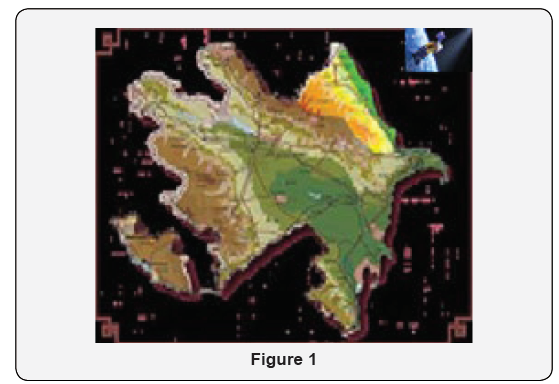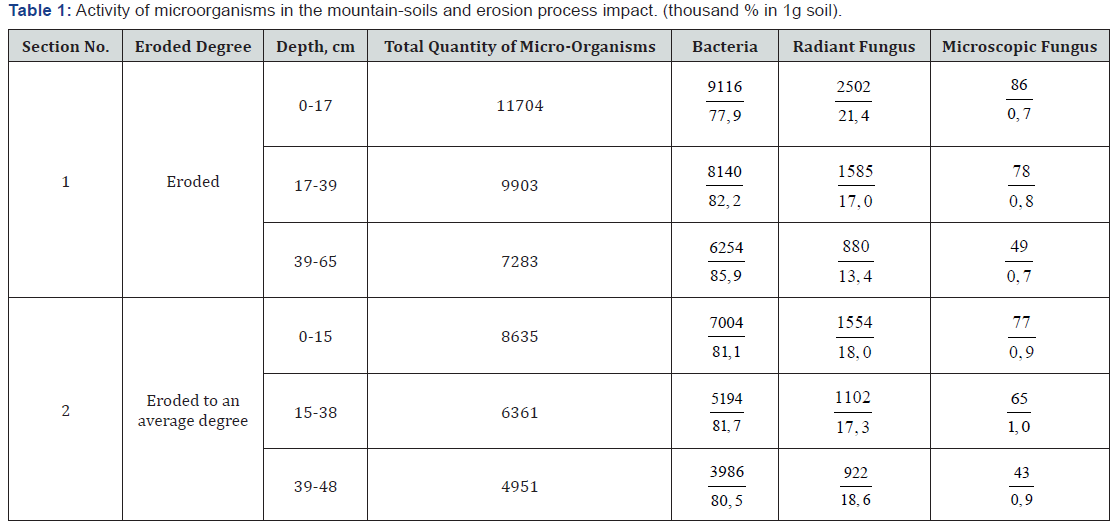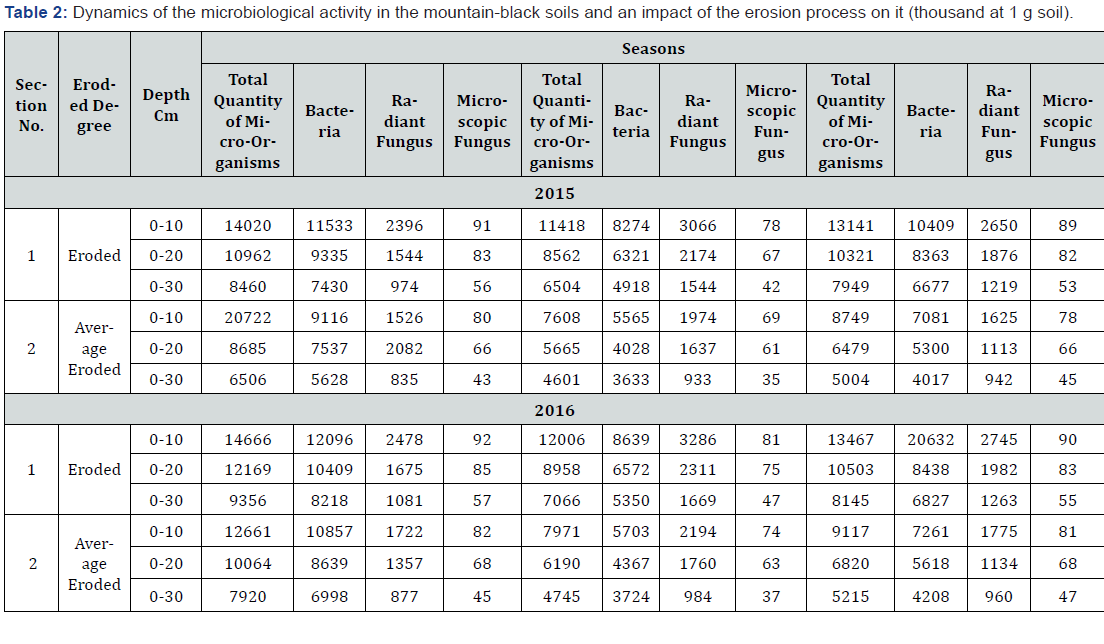Ecology & Conservation Science - Juniper Publishers
Abstract
The article discusses the impact of the erosion
process on mountain black terrestrial, suitable for planting soils
widespread in the Shamakhi region of Azerbaijan, which are subject to
erosion, which impairs its fertility, weakens fertility etc. It should
be recognized that the influence of agricultural activity of man on the
processes taking place in the soil is a deeply studied problem. What
contributed to the negligence of the soil, its incorrect and irrational
use which weaken its fertility, change the normal direction of the
process of soil formation. According to the latest data, more than 50%
of the soils of the Shamakhi region are subject to the process of water
and irrigation erosion, a process that is widely distributed mainly in
mountain black-terrestrial. According to well-known scientists of the
republic, it was found that substances synthesized by microorganisms
that regulate the complex processes occurring in the soil. For example,
the conversion of plant residues and organic substances into humus takes
place under the influence of complex environmental factors, which
impairs its fertility. This was compared to our study of the dynamics of
microbiological activity in black mountain soils and the effect of
erosion on it at the object of study. As you know, humus is the basis of
soil fertility. For this reason and in the process of research, the
factors that form the soil were the focus of genetic science on soil.
The results of the study proved that the erosion process, which occurred
in nature, possessing a huge potential for its destructive power,
destroys the surface fertile soil layer, cancels its fertility and,
therefore, removes soil from agricultural circulation. Being a dynamic
process, it changes the appearance of a zone, as a rule, a landscape
that is widely distributed in the mountainous and foothill zones of the
region. This is the reason for the change of the initial relief in the
morphological structure and mountain landscapes.
Keywords: Soil, Plant Erosion landscape Microbiological action
Introduction

(Figure 1) An importance of the biological processes,
mainly microbiological process is great in a period of the soil science
and biology science development, especially in biotechnology science
formation. The significance for the microbiological process in the xx
century is explained that an intensity of the processes in our
environment, biosphere is closely connected with microorganism’s
activity. Synthesis and resynthesis of organicsubstance, humus
mineralization and humification processes in soils are performed by
microorganisms. Microbiological process is great in decomposition of the
nutrient total forms, in provision of soils with the nutrient. It is already determined that the substances which
are synthesized by microorganisms regulate the complex process occurring
in the soil [1,2]. Turning of the plant residues and coarse organic
substances into humus mainly occurs under an influence of the complex
ecological factors and forms a basis of the soil fertility.
The Course of the Study
The microorganisms decompose organic substances in
the soil, turn the nutrient in their composition to a form which can be
appropriated for the plant, create a favorable condition for their
nourishment. The microorganisms also perform sanitary work, prevent from
contamination of the environment, especially, soil. As it is not noted
that there is a great role of the microorganisms in soil fertility
formation. They carry on the organic substance decomposition till the
whole mineralization. The plants synthesize the organic matter, the
animals fulfil its mechanical
Abstract
The article discusses the impact of the erosion process on mountain
black terrestrial, suitable for planting soils widespread in the
Shamakhi region of Azerbaijan, which are subject to erosion, which
impairs its fertility, weakens fertility etc. It should be recognized
that the influence of agricultural activity of man on the processes
taking place in the soil is a deeply studied problem. What contributed
to the negligence of the soil, its incorrect and irrational use which
weaken its fertility, change the normal direction of the process of soil
formation. According to the latest data, more than 50% of the soils of
the Shamakhi region are subject to the process of water and irrigation
erosion, a process that is widely distributed mainly in mountain
black-terrestrial. According to well-known scientists of the republic,
it was found that substances synthesized by microorganisms that regulate
the complex processes occurring in the soil. For example, the
conversion of plant residues and organic substances into humus takes
place under the influence of complex environmental factors, which
impairs its fertility. This was compared to our study of the dynamics of
microbiological activity in black mountain soils and the effect of
erosion on it at the object of study. As you know, humus is the basis of
soil fertility. For this reason and in the process of research, the
factors that form the soil were the focus of genetic science on soil.
The results of the study proved that the erosion process, which occurred
in nature, possessing a huge potential for its destructive power,
destroys the surface fertile soil layer, cancels its fertility and,
therefore, removes soil from agricultural circulation. Being a dynamic
process, it changes the appearance of a zone, as a rule, a landscape
that is widely distributed in the mountainous and foothill zones of the
region. This is the reason for the change of the initial relief in the
morphological structure and mountain landscapes.
Keywords: Soil; Plant; Erosion landscape; Microbiological actionand
biochemical decomposition and prepare for humus
formation in future. But the microorganisms finish the substance
decomposition, synthesize the soil humus, and decompose it
again when unfavorable conditions are created.
BG Shakuri [2] commented that all the organic wastes are turned
into the inorganic substance form because of the microorganisms’
activity. Without participation of microorganisms exposing of the
organic matters to such change and their appropriation by the
plants are impossible [3]. Besides it, they cause substances circulation in the nature, soil
fertility, oil and pit coal formation, mountain rocks weathering
and formation of the other natural phenomena. If there aren`t
rottenness microbes, the plant and animal remnants gather on the
earth and it can`t be possible to move. It was always defined that an intensity of the biochemical
processes occurring in the soil depends on physical, chemical
indices, environment development phase of plants, temperature,
humidity and other factors of the soil. Just therefore, as a result
of the presented factors change, an activity of ferments in soil
alters. In this connection an importance of the soil microflora is
great in assimilation of the soils, exposed to the anthropogenic
pressure and degraded. This is also connected with intensive use
of soils. Management of the soil fertility requires an investigation
and regulation of their biological activity. In this connection
some groups of the researchers gave the detailed information
about the soil Roo fauna, biochemical processes, physio-chemical
characters, anthropogenic soils genesis held on the international
congresses in the Turkey republic in 1998 and “ Anthropogenic
soil forming problem” held in Moscow in 1997 [4-7].
We should note that only physio-chemical methods aren`t
enough in investigation and analysis of soils. The soil scientists
already consider that the research of the biological processes is
a great problem in assimilation of the soils genetic characters,
clarity of their fertility peculiarities and definition of the processes
direction. Such an opinion is already formed that a closely
relation available between the plant-soil and microorganisms
was investigated for the purpose of soil fertility research.
Because of more humus in the mountain-black soils an activity of
microorganisms is quick.
Since before the xx century a role of microorganisms was
exactly investigated in creation of the complex processes,
including bio-chemical processes, especially humus formation,
turning of the atmospheric nitrogen to the biological nitrogen. In
connection with this problem ZH Aliyev, MP Babayev, PA Kostichev,
Vinogradsky, Shakuri BQ and others expressed opinions [3,4,7,8].
The authors show that the microorganisms` role is fixing in
decomposition of the plant residues, dead organic world and
coarse molecular organic substances and initial humus formation.
As is known the all groups in soil microorganisms are available
and the separate groups possess a special function. The enough
information was given about a participation of the same groups inhumus forming process. A role of microorganisms in soil forming
process and humus synthesis was studied by the Azerbaijan
scientists. It was determined that the microbiological activity
rises while a height of the zone increases till a definite level. The
number and activity of microorganisms aren’t at the same Level,
they depend on hydrothermal regime, fertility, structure, plant
cover, climate characters, humus supply, nutrient quantity and so
on.
All the sorts (surface, linear, irrigation, pasture and wind
erosion) of erosion in the region having a complex geological and
geomorphological structure develop and consequently the soils
fertility is disturbed, fruitfulness ability gets reduced. More parts
of the agricultural areas good for sowing deteriorated, but one
part was withdrawn from crop rotation. Here the rivers and other
water sources became turbid, provision of the local hydrological
regime and areas with humidity deteriorated [9]. The greatest
part of the Shamakhy region in which the first farming culture
develops is situated in the upland zone. Since very ancient
periods the relief condition complexity in the mountain zone
used in intensive farming and cattle-breeding is characterized by
splintering of the firm rocks, unequal distribution of rainfalls on
seasons and falling of the rains in a pouring form.
Materials & Discussion
As a result of the joint impact of the anthropogenic and natural
factors the soils expose to the erosion process, their upper rotten.
Layer are washed out and Lose their fertility. The humus quantity
in such soils gets reduced for the first time, its fraction structure
deathtime, its fraction structure deteriorates, the mobile part
of human acids which is agronomically valuable decreases. So,
erosion negatively affects the main parameters of the humus
forming process in soil. Erosion deteriorates decomposition of CO,
its respiration in soil [8,10].
The erosion process weakens the microbiological process
which is one of the main factors in soil fertility. It should be noted
that the soil microflora is a decisive factor of the biochemical
processes and regulates the humus synthesis and mineralization.
Generally, the erosion process deteriorates physico characters,
its water regime and food balance. The erosion process reduces
water supply of soil, creates arid conditions and this is dangerous
for dry- farming land.
An evaluation of all the factors (plant, soil, relief, climate and so
on) is required for a comparative character of the soil productivity
and fertility and this forms a complex valuation method of the
soils agro ecological condition. The microbiological processes in eroded and average eroded
kinds of the mountain-black and steppe mountain-brown soils
were investigated according to the seasons in the Shamakhy
region which is situated in the south-eastern part of the Great
Caucasus. An activity of bacteria, radiant fungus and microscopic
fungus from microorganisms was studied [9].
Study of the microbiological activity in the un eroded
mountain-black soils indicated that (Table 1) a total quantity
of microorganisms at 0-17cm layer of the same soils is 11704
thousand in one-gram soil, but it is accordingly 9903 and 7283thousand at 17-39 and 39-65cm stratums. Microorganisms gather
on the fertile surface stratum. The bacteria and radiant fungus
dominate inside microorganisms

As is shown from the figures of the table, the
microbiological
activity in the mountain-black soils were more than in comparison
with the other soil types. This is explained that the same soils
are rich in humus and nutrient. This creates conditions for a
development and normal activity of microorganisms. As is seen,
an extremal situation limits microorganisms’ development. The
erosion process weakens all the microbe groups’ activity. Decreaseof
humidity negatively affects an activity of microscopic fungus in
the same soils.
The microbiological activity of the mountain-black soils with
a large fertility potential is high very much. The microbiological
activity in un eroded and average eroded kinds of the mountainblack
soils was investigated according to the seasons and the
obtained results are presented on (Table 2).

a) Importance of the microbiological process which was
paid attention in the xx century is that an intensity of the
processes occurring in our environment, biosphere relates to
the microorganism’s activity. The organic substance synthesis,
rot mineralization and humification processes are performed
by microorganisms. A role of the microbiological processes
is great in decomposition of the total forms in the nutrient,
provision of soils with the nutrient.
b) The erosion process weakened the food potential in
the mountain-black and steppe soils, deteriorating the soil
fertility parameters limited its fruitfulness ability.
a. The fertility parameters were higher in the mountainblack
soils.
b. The mountain-black soils were provided with the
nutrient well
c) Because of the favorable structure in the mountainblack
soils, the soil composition is rich in organic matter.
The agrotechnical measures consist of performing the tillage
and all the cultivation works against the winds direction and
slopes diametrically and preserving in moist and so on.





No comments:
Post a Comment